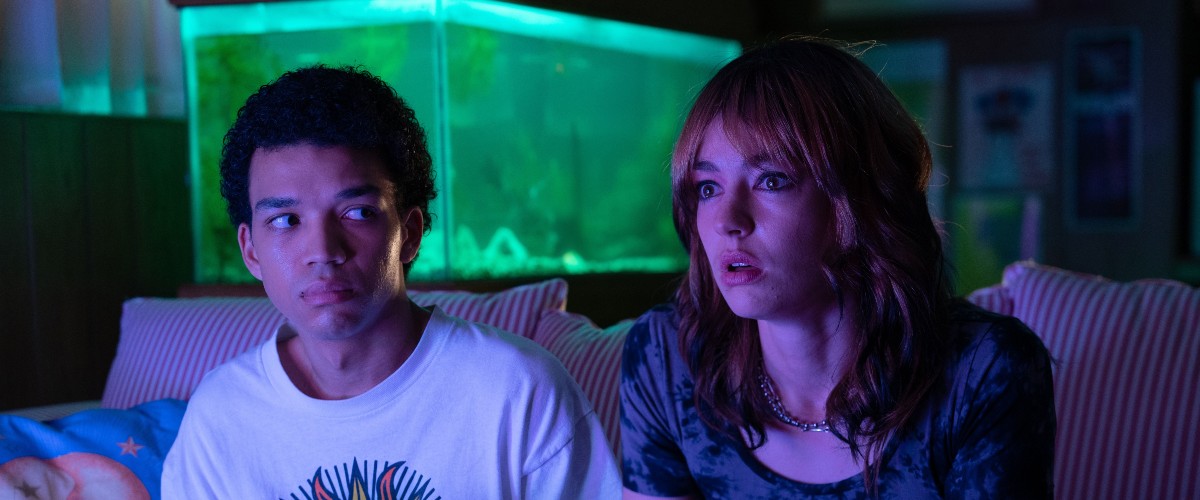
When I heard that the critically acclaimed indie horror film, I Saw the TV Glow, was partly an homage to Buffy the Vampire Slayer, I was beyond excited.
Buffy is my all-time favorite show. To me, its blend of humor, horror, teen (and, eventually, young adult) angst, and romance has never been surpassed. I watched it in a manner similar to I Saw the TV Glow’s protagonist, Owen (a heartbreaking Justice Smith.) I had missed the first three seasons, so I caught up on DVDs loaned to me by my friend Geoff. (In the movie, Owen watches on video tapes.) I remember that on the season three stack of DVDs, Geoff had scribbled, “Holy s&@$!” (IYKYK.) After that, I was able to watch in real time, in weekly installments. (This is how we used to watch television shows, children. Like barbarians.)
But here’s the thing. I was in my twenties when I first started Buffy, not a teenager. I’m not sure how I would’ve reacted differently to the material if I were a kid or searching for my identity in any way. It might’ve been more transformative—it might’ve grafted on me differently.
I say this because it took me a while to adjust to the gloomy, arty, lo-fi mood of I Saw the TV Glow. To me, the most outstanding aspect of Buffy is its sharpness, its wit, its heightened sense of irony. (And the hotness of vampire Spike in a leather coat, but I digress…)
But I can imagine to a young queer person, the show’s idea of outsiders having a divine purpose, being able to combat demons (actual ones, standing in for the metaphorical ones), and being part of a special secret sisterhood would be quite heady. (Later, the show explicitly honored its queer fanbase by making cute-nerd-turned-hot-witch Willow gay.) That’s the side of Buffy that I Saw the TV Glow writer/director Jane Schoenbrun, who is transfeminine, leans into.
Our action takes places in a small, nondescript suburban town, possibly named Void (the kids go to Void High). Young Owen (first played as a 7th grader by Ian Foreman) meets fellow outsider Maddy (Brigette Lundy-Paine) and she turns him onto The Pink Opaque, a show about two girls psychically bonded in their quest to vanquish a moon-like “Big Bad” named Mr. Melancholy. The show is explicitly based on Buffy, in terms of tone, title font, indie rock score, and various other similarities—Buffy also called its season-long antagonists Big Bads.
We see little clips of the show, starring Helena Howard as Isabel and Lindsey Jordan (Baltimore’s own Snail Mail!) as the cooler, tougher Tara. Funnily enough, the actress who played Tara on the original Buffy, Amber Benson, has a very sweet cameo here. But The Pink Opaque’s Tara is more like Buffy’s authority-defying Faith; Isabel is more a stand-in for Buffy herself. And the characters are meant to mirror Owen and Maddy. (Both Owen and Isabel are half-Black and the more cautious member of the duo.)
Maddy and Owen watch The Pink Opaque in her wood-paneled basement, with a huge aquarium bubbling beside them. Upstairs, her parents fight. Maddy’s father is abusive. Owen’s mother was doting, bordering on helicoptering, but when she dies of cancer, Owen is left in the care of his taciturn father, who spends all day watching TV. (We see him on the coach, as the flickering lights of the television dance across his motionless face.)
It’s Maddy who wants to leave home. Owen is too fearful. And then, just like that, she vanishes, leaving only a burning TV behind.
Is there something demonic going on in their small town, as Maddy posits. Or is it “just the suburbs,” as Owen responds sadly.
Maddy was empowered by The Pink Opaque to go off on her own hero’s journey. Owen, stuck permanently in his hometown, wastes away. (He narrates the film, from childhood all the way through middle age.)
I Saw the TV Glow is filled with beautiful, evocative images—not just the constant glow of television sets, but a billowing, tented planetarium the students build in school; a sensory-numbing amusement park, with more of those ever-flickering lights; and the tattoo-like, neon pink birthmark the Pink Opaque duo have inscribed on their necks. In one of the film’s most tender and intimate scenes, Maddy painstakingly draws the pink birthmark on Owen’s neck.
The film is also quite scary, in exactly the way Buffy could be—not with fancy special effects, but by tapping into something genuinely nightmarish and sinister. (Another Baltimore connection: local filmmaker Albert Birney helped with the construction of the monsters.) I do wish it were funnier, but that’s what made Buffy important to me—not Schoenbrun.
It’s telling how much I Saw the TV Glow, which is mostly set in the late ’90s, feels like a period piece. There was a time when television was crucial, unifying. Schoenbrun understands that, yes, we can be mesmerized, even zombified by these glowing images, but they’re not here to condemn television. They’re here to pay tribute.
Sometimes, a TV show could be a portal to a better world. Sometimes a TV show could save a life.
